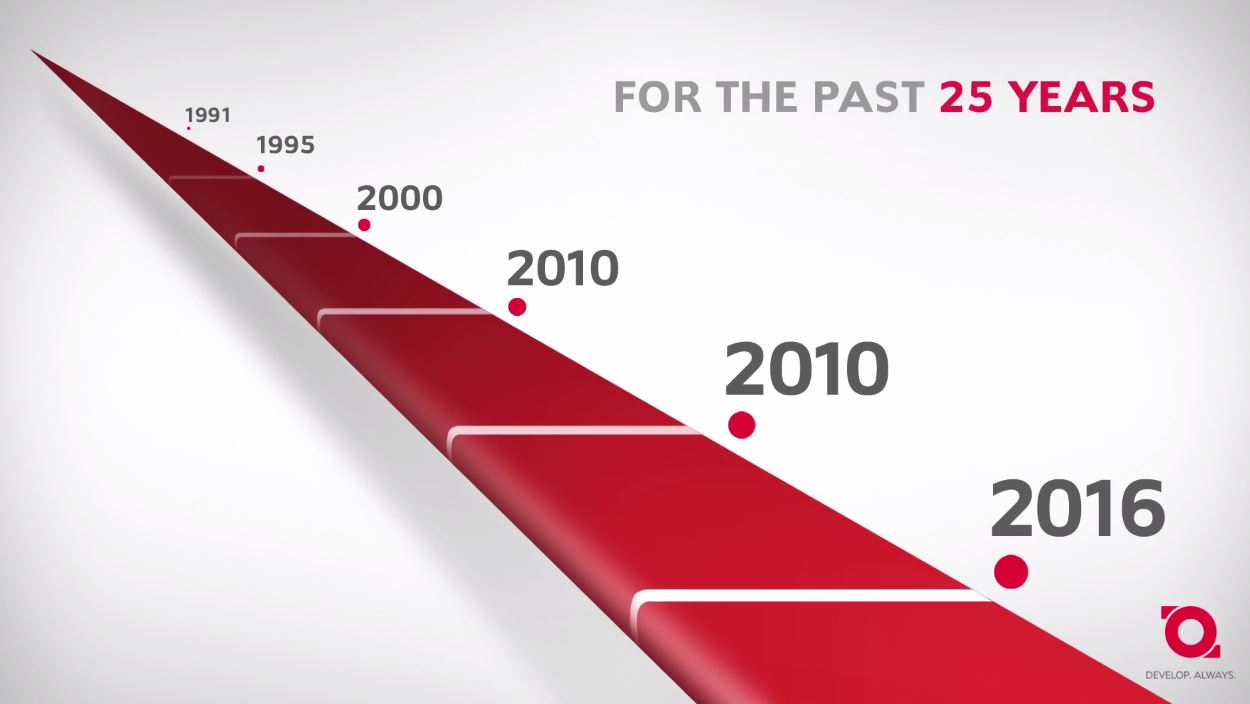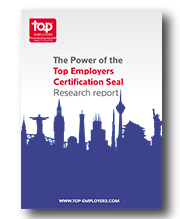Human Resources has been through a tough development process over the last 25 years. During this timeframe the Top Employers Institute has been active in this field, examining what employers offer their employees. Together with David Plink, CEO of Top Employers Institute we want look back at what has changed, from his point of view, and how the Top Employers Institute has evolved in relation to these changes.
David Plink

Recent Posts
Recognising excellence in employee conditions for 25 years
Transparency helps retention
Issues around talent retention and development remain high on the agenda for CEOs and senior HR professionals. In an uncertain economic climate with growing skill shortages, businesses can ill afford to risk losing valuable knowledge and intellectual capital, whether through retirement or a growing restlessness amongst younger workers.
Topics: Career & Succession management
4 facts that show the actual power of the Top Employer Certification
We conducted a study in 12 different countries in 2015 to showcase the power of the Top Employers Certification Seal. What specific impact does the Top Employer Certification Seal have on the attractiveness and image of a potential employer? How does a certification seal influence the attitude of a prospective employee towards a potential employer? How do young professionals perceive organisations that are certified as a Top Employer?
Topics: Culture
The way that we look at leadership is changing. With businesses facing the combined challenges of emerging technologies, newer working practices and increased employee and customer expectations, our approach to identifying and nurturing future leaders needs to evolve. Instead of focusing on a small group of pre-identified individuals, we now need to foster a more collective leadership mindset and build a culture in which future leaders can grow and thrive. Organisational culture is now a major differentiator for businesses looking to attract and retain the best talent, with leadership capability and agility a vital part.
There are two major shifts helping to drive this approach
-
Identification of potential leaders by influence, network and behaviours rather than by their role or position within the business. This arises from moving towards leaner, flatter, non-hierarchical organisations.
-
Individual employees taking responsibility for their own personal, career and leadership development, no longer leaving it to line managers or HR. Non-linear career paths and the need to keep skills up to date are driving this.
Individuals need encouragement. Along with a sense of career ownership they should develop an approach and mindset that will enable them to maximise their potential. An understanding of cultural and social sensibilities will be crucial for future leaders operating in a global marketplace. This experience can be gained through undertaking challenging projects, possibly outside the business. Similarly, an understanding of wellbeing and mindfulness will help to reduce potential stress and burn out from an always on-line/always connected business culture.
It is not only the recognised performers who need encouragement. All employees should be able to see leadership as something that is attainable if they can build and demonstrate the right behaviours and capabilities. The diversity and creativity of future organisations depends on it.
The need for an agile, flexible leadership approach is paramount. Many future business challenges are as yet undefined, whilst technology continues to disrupt many previously established business processes. Our Leadership Development programmes need to address this and help create change agents and people who can comfortably lead organisational change.
Top performing organisations are using all measurements to gauge the success of their programmes, yet many others tend to favour only subjective evaluations. The all-important commercial yardsticks of Return on Investment (ROI) and alignment with business performance shouldn’t be avoided.
To maximise employee involvement in development we need to give them a seamless learning experience that replicates much of what they expect from technology in their personal lives. At home they now have better, faster and more responsive tech than at work, and will respond more positively to a 'personalised' approach that puts them in the driving seat.
Encourage them to learn when, where and how they want. Mentoring, online coaching, video, social learning and collaboration are all ways in which the next generation of leaders expect to gain knowledge and access information. Businesses that deny them these methods, and particularly ones that make information difficult to access and share, could find themselves losing out on retaining the talent they need.
Topics: Leadership Development
What can you learn from the first Certified Top Employers Global 2015
The first Top Employer Global Certifications are awarded!
Since 1991, we certify excellence in the conditions that international companies create for their people. The introduction of a Top Employers Global Certification programme is a logical next step in view of the global trend in harmonisation of employee conditions. The first five Global Certifications have been awarded to Valeo, Technip, Dimension Data, JT International and DHL Express.
Topics: Employer Branding
We have seen many new employee conditions being introduced this year. The employers in our Top Employers research are continuously working to optimise their Human Resource environment and leading the way in the development of its people.
Topics: Compensation & Benefits
Global Certification for Top Employers with international HR strategy
Since 1991, the Top Employers Institute certifies excellence in the conditions that companies create for their people. The introduction of a Top Employers Global Certification programme is a logical next step in view of the global trend in harmonisation of employee conditions. The first Global Certifications will be announced during the Global Certification Dinner on March 5, at the Hermitage Amsterdam Museum.
Topics: Performance Management, Leadership Development, Compensation & Benefits, Career & Succession management, Workforce planning & Talent strategy, On-boarding
By investing in their Employer Brand, Top Employers invest in engaging and recruiting happy people. Stimulating happiness is not a soft relict from the seventies, but turns out to be one of the key indicators for high performing companies.
Topics: Culture, Employer Branding
Top Employers Automotive Research Results 2014 Infographic
"I really became hooked on developing individuals and in developing organisations,” says Peter-Paul Adriaansen resolutely. He began his career at DSM in 1986, which is where his future in HR really took shape. He then moved to Dutch retailer De Bijenkorf, before joining Philip Morris in 1996. He has since progressed to HR Director at Philip Morris Germany & Austria, about which he adds, “A favourite quote that we live by here is: ‘We develop our people and let them develop our business."
Quote: “Development is not a department but an attitude.” “My favourite part of the job is building towards the future,” professes Peter Pleunes. He freely admits that he has been enamoured by HR since his early university days, quickly learning that it was a crucial bridge between the operations of a business and the people within it. Thanks to this mind-set, he has enjoyed a diverse career in the field, working with companies such as Belkin and KPMG, before becoming the Director of Human Resources at Merck Serono in the Netherlands in 2009.
Top Employers South Africa Research Results 2013 Infographic
Outstanding benefits alone don’t make an employer outstanding
Some years ago I joined a new employer. And as these things go, I had an initial interview process, meeting various directors and the CEO. We mutually agreed that there was a fit and agreed to enter the actual negotiation process.
Topics: On-boarding
More than 20 years ago our company was founded as the Corporate Research Foundation (and rebranded in 2008 to the CRF Institute). The initial aim was to show who were the best employers in the Netherlands . Almost a quarter century onwards that objective has not changed. But the scale at which we now certify employers has most certainly changed.
Topics: Leadership Development
Wonderful and exotic working conditions – Taking care of employees beyond the pat on the back
“People are our most important asset” is a favorite of CEOs expressing the appreciation of their people. Top Employers from around the world are actually putting this into practice with some great examples of caring for their staff. And this goes way beyond the workplace. Some examples of wonderful working conditions from around the world: Some employers are currently offering Parenting Skills Training. Recognizing that personal and family worries are carried into the workplace (and vice versa) is at the start of these programs and more companies are taking this into consideration. Programs that are also offered in this field are: self-development workshops, work-life balance programs, healthy food and habits courses, first aid courses for infants and encouraging employees to find a hobby (painting, design, etc). And how about tutorial help for school-going children, marriage counseling and a special office for parent-child issues?
Topics: On-boarding
A few months ago, I posted my first blog on this platform with a promise to show you some of the wonderful and exotic examples of employee conditions. Here’s a selection in random order of some of conditions that the Top Employers 2013 are offering. Maybe not applicable to all of you, but nonetheless a source of inspiration.
We are currently in the middle of the Top Employers 2014 Certification cycle. We are assessing employers in more than 60 countries and we are seeing many great examples from what Top Employers are offering their employees in order to create optimal employee conditions for their people. The 2014 results are obviously not in yet, but we can show what Top Employers are offering this year. And there is one emerging trend that is visible across various employee conditions: the degree to which technology is influencing employee conditions.
Topics: Career & Succession management, Workforce planning & Talent strategy
Topics: Compensation & Benefits, Career & Succession management






















